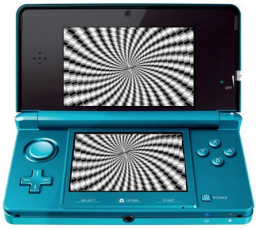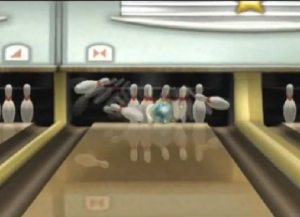Video games inspire theme parks
Posted: 06/06/2016 Filed under: Theme Parks | Tags: Nintendo, photosensitive epilepsy, seizures, Ubisoft, video games Leave a comment
Mass Effect: New Earth debuted May 18 at the Great America theme park in Santa Clara, CA.
People who have photosensitive epilepsy probably are already cautious about going to amusement parks, since lots of rides and other attractions feature fast-moving lights and flashing images. Now there’s another reason they should be wary: video game-based attractions are coming to amusement parks, and some of those games have seizure-inducing images.
“The game manufacturers and game designers want to have a place to show their games at a scale that you can’t do in your house,” according to the CEO of Cedar Fair Entertainment Company, which owns 11 amusement parks. To put it another way, they’re blowing up the visuals of an action video game with seizure risks, and displaying those images on a huge screen!
Here’s the problem with that: Images on an oversized screen have a greater impact on the brain’s visual cortex than the same images viewed smaller. This means that even if a person with some degree of visual sensitivity plays Mass Effect on an Xbox, without incident, that person would be more likely to experience a seizure at the theme park attraction.
Games don’t comply with seizure guidelines

The Mass Effect attraction is viewed on a 60-foot screen, behind a live actor (lower right)
An attraction based on BioWare’s Mass Effect opened last month at California’s Great America theme park—on a 60-foot LED screen. Curious about whether the at-home games contain potentially seizure-provoking images, I tested** the images in promotional trailers for Mass Effect 3 and Mass Effect 4. I found violations of seizure reduction guidelines in both. A 15-second commercial for Mass Effect: New Earth also fails the test for compliance with the guidelines.

a frame from the Plants vs. Zombies Garden Warfare PlayStation launch trailer
At North Carolina’s Carowinds amusement park, “the world’s first intra-active 3-D game experience” Plants vs. Zombies Garden Warfare: 3Z Arena opened in March. It’s shown on screens measuring 14.4 x 26 feet.
The attraction is based on the Plants vs. Zombies franchise. In my tests, some clips from the Plants vs. Zombies Garden Warfare game violate seizure reduction guidelines. I didn’t have video I could test of the park’s big-screen experience.
When designing an attraction based on a game with seizure-provoking images, shouldn’t the theme park industry be especially mindful of patrons with photosensitive epilepsy? Warnings at the park about rides that could be hazardous to patrons with certain medical conditions such as pregnancy, heart conditions, or epilepsy aren’t enough. Many people don’t even know about their vulnerability to seizures from certain visual effects until they have an unmistakable seizure. Not all seizures are easily noticeable! And even small seizures that aren’t seen can leave impairing after-effects.
Coming next: Entire theme parks based on games
Video game-based attractions at amusement parks are expected to multiply. Universal Studios and Nintendo signed a deal last year to bring Nintendo-based attractions to Universal’s theme parks. The first of these, slated for 2020 completion, will be a whole section of Nintendo-based attractions at an existing theme park in Osaka, Japan. Industry observers suspect that Universal’s recent land purchase in Orlando is intended for a Nintendo-based expansion of its Universal Orlando theme park. Ubisoft has announced an entire “next generation theme park” scheduled to open in 2020 in Kuala Lampur, Malaysia, with rides and attractions based on its portfolio of game franchises.
**Seizure reduction guidelines and testing images for compliance
You can read about seizure reduction guidelines here–they were developed in the UK to reduce the risk of seizures induced by TV. All material broadcast on UK television must comply with the guidelines.
To test images for the likelihood of provoking photosensitive seizures, I run downloaded video clips through an application called the Harding Flash and Pattern Analyzer. (Graham Harding is one of the world’s leading experts on photosensitive epilepsy.) The FPA is widely used by producers and networks in the UK—including by the BBC—to reduce the risk of seizures from material on broadcast TV.
The analyzer examines video sequences frame by frame for very specific and measurable image qualities that researchers have found can trigger seizures. When such images are found, it displays and indicates the specific frames that violate seizure reduction guidelines. Violations occur with:
- rapidly alternating light and dark images (flash/flicker)
- certain stripes and geometric patterns with high contrast
- large areas of very bright (“saturated”) red
- problem images take up more than one quarter of the total screen area
2 of these 4 Xbox games don’t cause seizures!
Posted: 12/04/2014 Filed under: Results of safety testing | Tags: computer games, flash, flicker, Nintendo, photosensitive epilepsy, Playstation, seizures, Sony, video games Leave a comment
First-person shooter game Halo: The Master Chief Collection was one of the recommended Xbox titles with a higher seizure risk.
Half of the Xbox-exclusive games selected by GamesBeat for its 2014 holiday gaming guide appear to be free of seizure-provoking visuals. There were just 4 Xbox games in the buying guide, so we’re talking about exactly 2 games that meet seizure safety guidelines. I don’t know how representative this sample is of the universe of Xbox-exclusive titles.
Disney Fantasia: Music Evolved isn’t a game in the conventional sense; it’s a rhythm game played by the motion of the player’s arms, enabled by the motion-sensing Kinect controller. There are no battle scenes that might set off visually risky explosions, or races with crashes and fast-moving scenery. Instead, when players “conduct” to the beat of music selections, all sorts of colored patterns are created and set in motion on the screen. It’s visually interesting yet not overstimulating. There’s a lot of black space separating the smaller colorful elements.

Sunset Overdrive, released by Microsoft Studios, is a third-person shooter game, a relatively low risk genre, seizure-wise. Because these games tell a story from the perspective of an observer of the action, scenes are shown from a wide angle. This means that, unlike first-person shooters, any bright, explosive flashes and rapidly swirling debris don’t dominate the field of view. The larger the screen area of patterns flashing images, the higher the likelihood is that those visual effects might provoke a seizure.
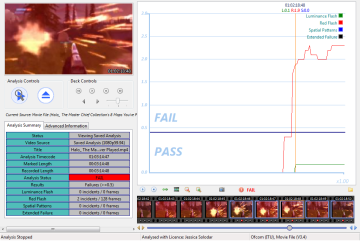
The Halo image at the start of this post is shown here in the upper left of a screen from the seizure safety testing application. The image occurs in a stretch of gunfire with flash levels exceeding seizure safety guidelines, as shown by the red line on the graph.
So it’s not surprising that first-person shooter Halo: The Master Chief Collection contains seizure-provoking images. Its predecessor Halo 4, which I tested 2 years ago along with other FPS games, failed the flash and pattern analyzer test, too.
Not so surprising, either, that the racing game Forza Horizon 2 violated seizure safety guidelines. As I’ve previously found, the quick cuts, fast-moving scenery, and dramatic collisions featured in the racing genre result in games that exceed or approach seizure safety guidelines. The original version of the game, which I tested nearly a year ago, contained a lot of scenes that flirted with safety guidelines limits, but I didn’t find actual violations.
Summing up GamesBeat’s 2014 holiday gift guide
This completes my seizure risk assessment of games chosen for GamesBeat’s 2014 holiday gift guide. In recent posts I’ve reported on the risk of seizures in the guide’s recommended multiplatform games and games exclusive to Nintendo, Sony, and PCs. After testing all 43 games in the GamesBeat 2014 holiday guide, it appears that 26 titles–60 percent–contain image sequences capable of provoking seizures.

Just 40 percent of games recommended in the GamesBeat holiday guide complied with seizure safety guidelines.
These are supposed to be the industry’s best games–how often is higher seizure risk is associated with the worst games? Or the not-especially-noteworthy? If I had unlimited time and testing resources, we could find out. Consumers deserve to see reviewers rate games for seizure risk, not just for graphics quality, speed/performance, modes of play, characters’ personalities, levels of difficulty, modes of play, frame rate, music, and so on.
Disclaimers
Please remember that your results could vary. Games that pass the seizure guidelines test could have seizure-provoking sequences that I was unable to locate. I don’t do this testing while actually playing these video games and I don’t see all the scenes. Instead I work with video clips available online, some of which are official marketing and gameplay trailers and cutscenes; others are gameplay sessions posted by reviewers or fans. I do not test fans’ gameplay clips if the original game was modified with other software.
In addition, the seizure threshold of individuals is affected by a number of factors including illness, hunger, stress, fatigue, length of play, and menstrual cycle, among others. So a game that seems OK may subsequently trigger a seizure under different conditions.
Testing methodology
I run downloaded gameplay clips, cinematic clips, and promotional trailers for each game and submit the sequences to the Harding Flash and Pattern Analyzer. The FPA is widely used by producers and networks in the UK—including by the BBC—to protect most (97 percent) but not all people with photosensitive epilepsy viewing broadcast TV. It examines video sequences for very specific and measurable image qualities that researchers have found can trigger seizures:
- rapidly alternating light and dark images (flash/flicker)
- certain stripes and geometric patterns with high contrast
- large areas of very bright (“saturated”) red
- problem images take up more than one fourth of the screen
If the first clip I test of a game fails the safety test, I move on to test the next game. I typically test at least 4 or 5 additional clips of a game if no violations are found initially. If I have a high level of suspicion due to the game genre and/or overall look of the sequences that there might be unsafe “footage” that I haven’t yet found, I may test a lot more clips.
Seizures from 7 of 11 best Nintendo games
Posted: 11/21/2014 Filed under: Results of safety testing | Tags: computer games, Nintendo, photosensitive epilepsy, seizures, video games 3 Comments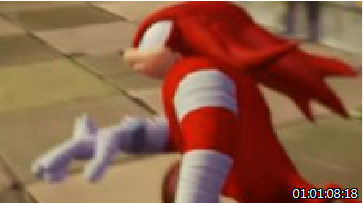
A case history in a 1994 medical journal documented seizures in a 13-year-old boy that were triggered by a Sonic the Hedgehog video game. The Sonic games just tested continue to include seizure-inducing sequences.
Thinking about buying any titles that GamesBeat thinks are the season’s best Nintendo-only games? My testing shows that seven contain seizure-provoking visuals.
Among the Nintendo games that don’t comply with seizure safety guidelines are several that one would expect to be seizure-inducing. Two brand-new animé-style games, Persona Q and Hyrule Warriors, predictably violated the safety guidelines because animé typically does. Unsafe graphics in Sonic the Hedgehog and Super Smash Bros., two of the most well-established game franchises, are consistent with prior seizure-provoking games in their respective product families.

GamesBeat picked these Nintendo-only titles for its early holiday gaming guide this year.
Pokémon video games…
Keeping in mind the so-called Pokémon incident in 1997, I was particularly curious about the seizure risk from the Pokémon games. That event was a Pokémon cartoon broadcast, when about 600 Japanese children simultaneously experienced seizure symptoms severe enough that they were taken to emergency rooms. Maybe because of that history, I thought, perhaps the developers of these games have taken extra care to reduce the risk of photosensitive seizures.
In fact, in the segments I tested of these three games, there were no images that violate seizure safety guidelines. Of the three Pokémon games, one isn’t really a game so much as a set of digital drawing and painting tutorials. Still curious, I put a few other Pokémon games through a seizure guidelines compliance assessment—the others passed, too.
…and Pokémon video game trailers
Hold on, though. Although the Pokémon games themselves games comply with guidelines to reduce seizure risk, a promotional video for these same games violates the guidelines big time! How can that be? Here’s how: a just-released trailer for Pokémon Alpha Sapphire and Omega Ruby is done in a more traditional animé style, while the Pokémon games themselves still use the not-very-animated, not-very-2014, unlikely-to-provoke-seizures animation style of much older games. So beware of seizures from the marketing videos.

…than the Pokémon games it’s promoting. While the game is safe, the eye-catching trailer fails the seizure guidelines compliance test.
Evidently unaware of the seizure hazard from animé, Sports website Sportskeeda.com commented:
“To celebrate the upcoming release, the Pokémon Company has launched an animé style trailer for the two games…It’s pretty cool of Pokémon to release an animé styled trailer, given how popular the series and manga is. And even though the animé and game are very different from each other, fans of the series are still going to appreciate the extra effort.”
When The Pokémon Company in 2012 used this same marketing strategy with an animé promotional trailer to “celebrate” the release of non-animé Pokémon Black 2 and Pokémon White 2, YouTube viewers of the combined trailer lamented that the (seizure-inducing) animé in the promotional clip looked a lot better than the humdrum (visually safer) appearance of the games’ graphics.
These visually jazzed-up trailers would seem to raise customers’ expectations that in future releases The Pokémon Company intends to incorporate animé style into cutscenes and perhaps gameplay.
Testing Methodology
Here’s how I test for compliance with seizure safety guidelines. I submit downloaded gameplay clips and promotional trailers to the Harding Flash and Pattern Analyzer. The FPA is widely used by producers and networks in the UK—including by the BBC—to reduce the seizure risk in viewers from all material broadcast on TV. It examines video sequences for very specific and measurable image qualities that researchers have found can trigger seizures:
- rapidly alternating light and dark images (flash/flicker)
- certain stripes and geometric patterns with high contrast
- large areas of very bright (“saturated”) red
- problem images take up more than one fourth of the screen
Sequences submitted for analysis are video clips available online, some of which are official marketing and gameplay trailers; others are gameplay sessions or cutscenes posted by reviewers or fans. I do not test clips uploaded by fans who have modified the game software.
I typically test at least 4 or 5 clips of a game if no safety violations are found in the first clip. If I have a high level of suspicion due to the game genre and/or overall “look” that there might be unsafe images that I haven’t yet found, I may test a lot more clips. Before finding a clip of Bayonetta 2 that failed the test, I tested about a dozen clips. Its large, fast-moving, brightly colored designs led me to believe there had to be seizure-inducing sequences.
Disclaimer
Your results could vary. Games that pass the compliance test could have seizure-provoking sequences that weren’t in the material I tested. Also, the seizure safety guidelines are designed to protect most (97 percent) but not all people with photosensitive epilepsy.
A game that has caused a person no problems over an extended period of use could still trigger a seizure in the same individual at a different time under different conditions. For reasons not understood by researchers, a person’s vulnerability to visually stimulated seizures changes over time. Photosensitive epilepsy can remain latent during childhood and typically emerges and peaks durng adolescence, and only about 25 percent of people who develop the condition will eventually outgrow it. Furthermore, the seizure threshold of individuals is affected by a number of factors including illness, hunger, stress, fatigue, alcohol, and the player’s menstrual cycle, among others.
Nintendo, Activision, Ubisoft preview unsafe games at E3
Posted: 06/13/2014 Filed under: Results of safety testing, Video Game Companies | Tags: Activision, computer games, E3, epilepsy, flash, flicker, Nintendo, photosensitive epilepsy, seizures, Ubisoft 2 Comments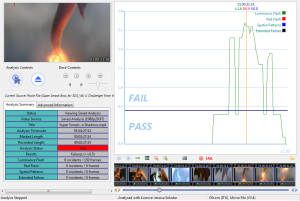
The image shown in the upper left of this screenshot, from Nintendo’s Super Smash Bros., is one frame in a flashing sequence in that fails the seizure safety test. The graph on the right shows the brightness of the flash exceeding the safe limit.
The 2014 E3 (Electronic Entertainment Expo) just wrapped up in Los Angeles with all the major game publishers previewing their upcoming releases. The big companies publishing these games have mammoth budgets and should be able to fund some quality control that supports the interest of public health. Apparently that line item is still not getting the focus it deserves.
Last week PCMag.com listed the 10 most anticipated games to be announced at E3. How many of them might trigger seizures in people with photosensitive epilepsy?

Destiny, a massively multiplayer first-person shooter game to be released in September, fails the safety test, too. Unlike the Nintendo game, it’s a completely new product. Both screen shots are taken from the Harding Flash and Pattern Analyzer, which tests images for seizure safety.
So far, 4 of them tested positive for seizure-inducing sequences–meaning they failed the Harding automated seizure safety test. This isn’t a final result because not all have enough “footage” available online for me to test adequately. Some may ultimately seem safe.
These tested as unsafe:
Super Smash Bros. (Nintendo)
Call of Duty: Advanced Warfare (Activision)
Destiny (Activision)
Tom Clancy’s The Division (Ubisoft)
In other words, the patterns, flashes, and/or red intensity of onscreen images produce the exact type of visual stimulation–that’s been carefully defined by researchers–that places viewers at risk of photosensitive seizures. People with a genetic predisposition for these seizures are vulnerable, whether or not they have ever experienced a seizure before, and whether they even know they have this genetic trait.
Nintendo’s Mario games have been triggering seizures for more than 20 years. Reports began surfacing in 1992 about seizures from Super Mario. As a result, a study on video game seizures published in 1999 used Super Mario World to test subjects known to be photosensitive. And a lawsuit was filed in 2001 by parents of a boy who had a seizure while playing Super Mario Kart.
But what about new games such as Destiny? A whole new game provides the perfect opportunity to create an entirely novel visual experience. Why not architect the whole thing keeping in mind the seizure hazard that persists in many games?
In sum, some of the video game industry’s biggest players are continuing to ignore safety guidelines, placing the public at unnecessary risk. I don’t know where the myth originated that games produced nowadays don’t produce seizures.
Can handheld games trigger seizures?
Posted: 02/21/2014 Filed under: Results of safety testing, Seizure Risk | Tags: 3DS, computer games, flash, Nintendo, photosensitive epilepsy, photosensitivity, seizures, video games Leave a commentThink the screen of a handheld game is too small to provoke seizures?
It isn’t. Games on the 2.9 inch screen of Nintendo’s Game Boy Advance SP provoked quite a few seizures in my daughter when she owned one ten years ago.
Nintendo’s current handheld is the popular 3DS console, which has a 3.5 inch screen. I recently tested some 3DS games to ascertain their seizure safety.
The rule of thumb (as it were) is that, for flashing and patterns to trigger seizures, the provoking image must take up at least one fourth of an individual’s visual field. It’s not unusual for kids to hold their portable games at close enough range for that small a screen to fill that much of their total view. Incidentally, although concerns were raised when the 3DS was introduced three years ago, there isn’t any conclusive evidence that 3D effects increase the risk of seizures in people who are photosensitive.
The IGN.com website recently identified the 14 most anticipated 3DS games for 2014 release. Here’s how they fared when tested for compliance with guidelines for preventing visually induced seizures; 6 of the 14 failed, and an additional 5 came close. Tests were done using the Harding Flash and Pattern Analyzer.
Here is how these highly anticipated 3DS games performed as far as meeting image safety guidelines for preventing photosensitive seizures:
Yes, there are seizure warnings on all game packages, but the warnings are pretty worthless for consumers. A year ago I posted about Nintendo being fully aware of, but publicly downplaying, the risk of seizures from its games.
Lawsuits filed after games caused seizures
Posted: 04/06/2013 Filed under: Legal Action, Seizure Warnings, Video Game Companies | Tags: American Academy of Pediatrics, computer games, Nintendo, photosensitive epilepsy, photosensitivity, product liability, seizure warning, Sony, Ubisoft, video games 3 Comments No consumer has won a product liability/personal injury case against a game manufacturer whose video game triggered seizures. Cases were either dismissed, settled, or won by the game company.
No consumer has won a product liability/personal injury case against a game manufacturer whose video game triggered seizures. Cases were either dismissed, settled, or won by the game company.
Despite their limited usefulness to consumers, seizure warning notices do seem to provide legal protection to game publishers. And juries have a hard time awarding damages to plaintiffs with a pre-existing condition, even if plaintiffs didn’t know of their photosensitive epilepsy prior to the seizure(s) triggered by a video game.
In one case Nintendo actually conceded that its game had in fact triggered seizures, but that didn’t get in the way of the company winning the case. A judge later overturned the jury’s verdict because Nintendo had withheld critical information in contempt of court.
The cases date back to 1991, but the apparent total number of cases–ten–is pretty small. One has to wonder what percentage of the seizures triggered by exposure to video games are ever identified as visually induced seizures.
One of the few consumers to reach a settlement is John Ledford of Alabama, whose settlement agreement bars John from discussing his own case. John has found another way to raise awareness of video game seizures. He has researched other cases and reached out to epilepsy organizations around the globe to raise their awareness of the continuing seizure hazard from video game images. John’s Facebook page contains most of the history I’ve assembled here:
| Year Filed | State | Plaintiff(s) | Game(s)/Platform/Defendant | Outcome |
| 1991 | MI | 15-year old Laura Moceri had grand mal seizure while playing. | Kid Icarus (Nintendo) | Lost |
| 1993 | IL | Chicago boy suffered occasional seizures during many hours of game play. | Nintendo | Dismissed |
| 1995 | AL | John Ledford had his first ever grand mal seizure while playing game at an arcade. The seizure damaged his optic nerve and caused blindness in one eye. | King of the Monsters II (SNK Corp.) | Settled |
| 1998 | LA | 13 year-old Joey Roccaforte had clusters of violent seizures | Mega Man X (Super Nintendo) | Jury ruled for Nintendo; judge later vacated the decision because Nintendo withheld critical information before and during trial. |
| 2001 | LA | Esther Walker, mother of 30-year old Benjamin Walker, who died from hitting his head on a table and sustaining internal injuries during a game-induced seizure. | Nintendo 64 | Lost |
| 2001 | LA | 11 year-old Michael Martin, son of Eric Martin, mayor of St. Martinsville, LA. Seizures that began happening during games began occurring also during sleep. | Super Mario Kart (Nintendo 64) | Settled personal injury claim; lost case advocating better warnings. |
| 2001 | LA | 6 year –old Kynan Hebert, son of Lynette Benoit | Nintendo | Dismissed |
| 2002 | FL | 16 year-old Dominic Zummo | Star Wars Episode I: Jedi Power Battles (LucasArts Entertainment, SONY) | Unknown |
| 2007 | NY | While watching his brother play a game, 4 year-old boy had a seizure causing permanent injury. | Spyro: Enter the Dragonfly (Vivendi, SONY Playstation 2) | Last available information: attorney for plaintiff was seeking other plaintiffs for class action suit |
| 2011 | CA | Navy F-18 pilot John Ryan McLaughlin injured in a grand mal seizure that causes permanent loss of flight status | Oblivion: The Elder Scrolls IV (Bethesda Software), Sony Playstation 3. | Still pending; no other information available. |
What constitutes product liability?
In 1997 the criteria for product manufacturer’s liability for a product that has caused harm were revised by the American Law Institute, an independent body of legal experts that drafts and publishes restatements of common law in order to clarify and simplify it. Its work is used as a resource by state lawmakers, judges, and lawyers. Every state has its own laws concerning burden of proof, the awarding of damages, and the like.
The 1997 restatement of product liability law states, “a product is defective when, at the time of sale or distribution, it contains a manufacturing defect, is defective in design or is defective because of inadequate instructions or warnings.” These conditions are then defined separately:
- A product “contains a manufacturing defect when the product departs from its intended design even though all possible care was exercised in the preparation and marketing of the product.”
- A product “contains a design defect when the foreseeable risks of harm posed by the product could have been reduced or avoided by the adoption of a reasonable alternative design by the seller or other distributor, or a predecessor in the commercial chain of distribution, and the omission of the reasonable alternative design renders the product not reasonably safe.”
- A product “is defective because of inadequate instructions or warnings when the foreseeable risks of harm posed by the product could have been reduced or avoided by the provision of reasonable instructions or warnings by the seller or other distributor, or a predecessor in the commercial chain of distribution and the omission of the instructions or warnings renders the product not reasonably safe.”
Some game companies are apparently working to make games that do not provoke seizures, but only Ubisoft has made a public commitment. As far as I can tell, most are merely reworking their warnings.
Nintendo knew about, downplayed seizure risks: BBC report
Posted: 02/20/2013 Filed under: Legal Action, Seizure Risk, Seizure Warnings, Video Game Companies | Tags: computer games, flash, flicker, Nintendo, photosensitive epilepsy, seizures, video games 5 Comments
Nintendo’s Mega Man X was one of the four games tested by the BBC for this investigative report that did not meet British TV seizure safety guidelines.
A BBC report on Nintendo revealed that the company knew more than 20 years ago which of its games were most likely to cause seizures–and downplayed the seizure risk to customers. A former Nintendo customer relations employee interviewed for the story said that many customers called to complain about experiencing seizures. Because he wanted to advise customers concerned about the seizure risk, he asked the company’s R & D group for a list of the games most likely to cause seizures.
Developers came up with a list of more than 30 games. Before the list was released to customers, he said, the company’s lawyers pared down the list to 12 – 15 titles. As customer complaints about seizures grew, Nintendo stopped releasing any seizure information about specific games. The Nintendo executive interviewed asserted that the company began making its games safer and started including seizure warnings with game instructions as soon as the problem came to their attention—in 1991.
The story, featured on the BBC’s Outrageous Fortune program in 2004, also includes an interview with photosensitive epilepsy expert Prof. Graham Harding. Using his own flash and pattern analyzer Prof. Harding shows the results of testing some Nintendo games for seizure safety.
To view the ten-minute segment about video game seizures in the report on Nintendo, first go to www.youtube.com/watch?v=0aFhW56c2Vg and fast forward to about 5:15 into the clip. The seizure segment continues at the beginning of this clip.
The documentary was never aired in the US, and I’d long since given up searching for it online. But I recently came upon it thanks to John Ledford, who has been tracking seizure lawsuits filed against the game industry. John became blind in one eye as a result of his first grand mal seizure—which occurred while he was playing a video game in 1994.
Wii helps doctors locate seizures (!)
Posted: 10/21/2011 Filed under: Diagnostic Challenges, Media Coverage | Tags: computer games, EEG, epilepsy, Nintendo, seizure warning, seizures, video games, Wii Leave a commentA local health feature broadcast this week in South Bend, Indiana credits the Wii for helping doctors identify where in the brain children’s seizures occur. When patients are in the hospital for seizure monitoring, doctors want to capture actual seizures in order to gather potentially valuable EEG data. If seizures don’t occur with the monitoring equipment in place, it’s a missed opportunity to collect information doctors can use to guide seizure treatment.
To increase the chances that seizures can be captured during the EEG monitoring, now the kids play Wii games! Thanks to the Wii, seizures are more likely to happen when they can be most helpful to doctors. The Wii has allowed seizures to be recorded on EEG in at least 25 percent more patients, according to the story.
“The most important purpose is to get them tired. We know that if you’re very tired, you’re more prone to have seizures,” explains Dr. Angel Hernandez, the neurologist interviewed for the story. Although fatigue lowers the body’s seizure threshold, it’s not the fatigue itself that produces the seizure. No matter how tired you are, without the visual stimulation of the video game, you’re not very likely to have a seizure.
Of course, the elephant in the room here is that video games do commonly trigger seizures, whether or not doctors deliberately provoke them and whether or not they are even noticeable events. You don’t really need to tire out the kids with the physical activity of Wii games. Just get them seated with any brightly flashing game screens, and you can produce the same results. Unfortunately the health reporter for this story did not explore the problem that is the flip side of Wii as a seizure trigger. I have to wonder how pleased Nintendo’s public relations people are with this particular feature story.



